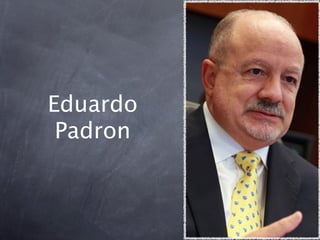Pace presentation
- 2. 15-year-old Eduardo and his 12-year-old brother left Cuba with just a suitcase full of clothes, landing in a country where they knew almost nothing.
- 3. Padron describes his first experiences in U.S. public schools with one word: "terrifying." "I got to the school and I didn't understand a word and everything was alien to me,"
- 4. "The teacher and students are talking to you and you don't know what they're saying. Not being able to communicate, not being able to understand the homework assignment.
- 5. He worked three jobs, delivering the newspaper, doing inventory at a department store and separating clothing at a dry cleaners.
- 6. ...
- 7. Eduardo sat in his high school counselor's office, ready to discuss his future and fulfill the promise he had made his mother before leaving Cuba.
- 8. But the counselor told Padron he wasn't college material. ... You should apply to a trade school, she said.
- 9. "When she said that, the voice of my mother in the back of my head was telling me, 'No, you're going to college and you can do much better,'
- 10. Rejecting the counselor's advice, he applied to many schools. He was accepted at just one
- 11. Padron enrolled in Miami Dade Community College, which was just one campus and about 5,000 students, mostly from poor and working-class families who couldn't afford larger private and state universities.
- 12. Padron would wake up at around 4:30 a.m. each morning and take three buses or carpool with students who each pitched in a quarter for gas and squeezed into a car
- 13. He'd take early classes and then head back to work. ... the stress of going to school, working and caring for his younger brother took a toll
- 14. This, Padron says, "was the place where I gained self confidence. Where I truly felt I belonged." He found a group of supportive students who had similar stories and concerns, and dedicated professors.
- 15. His academic career flourished, culminating with a doctorate from the University of Florida in 1970.
- 16. Padron returned to Miami Dade Community College in 1995 as ...
- 17. President!
- 18. Miami Dade College is now one of the nation's largest institutions of higher education, with more than 170,000 students and eight campuses
- 19. Time magazine named him one of the 10 best college presidents in the United States - the only community college leader on the list.
- 20. Takeaways! Never let anyone tell you "you can't" - make it your mission to prove them wrong. Follow your own path. Follow your passion! Give back.




















